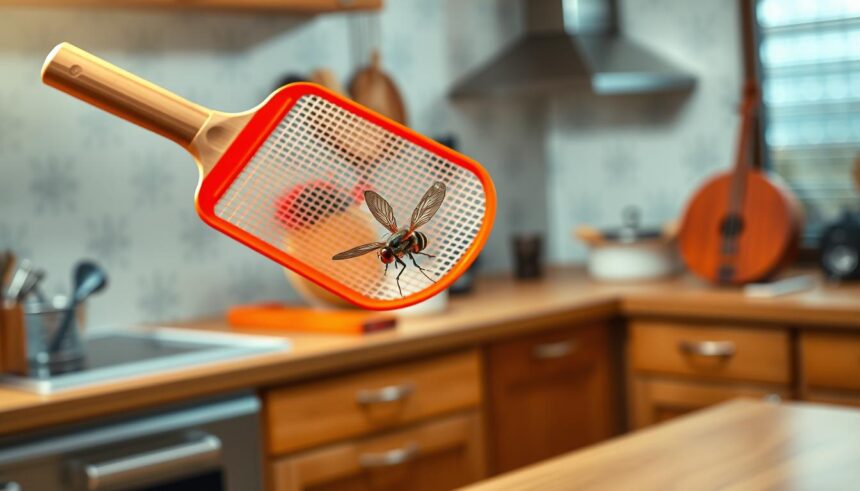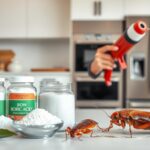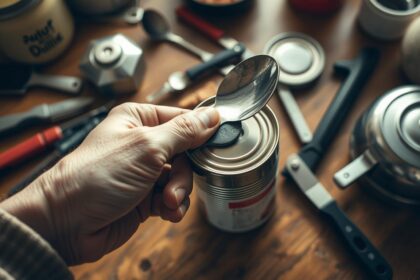Are you tired of dealing with pesky flies in your home? They can be a real nuisance and even a health risk. Flies can contaminate your food and spread diseases, so it’s important to find a way to get rid of them.
Don’t worry, you don’t need to spend a lot of money or use complicated methods to get rid of flies. Simple, DIY solutions can work well to keep your home fly-free. In this article, we’ll look at easy ways to eliminate flies for good.
Key Takeaways
- Identify common sources of fly infestations
- Learn simple DIY methods to eliminate flies
- Discover effective ways to prevent future fly problems
- Understand the importance of maintaining a clean environment
- Explore natural and non-toxic solutions to get rid of flies
Understanding the Enemy: Types of Common Household Flies

Not all flies are the same. Knowing the differences is key to getting rid of them for good. When you’re dealing with a fly infestation, understanding the types of flies invading your home is important.
Household flies can be broadly categorized into several types, each with unique characteristics and habits. Let’s explore the most common types of flies you might encounter in your home.
House Flies: Identification and Habits
House flies are one of the most common types of flies found in homes. They are typically gray with four black stripes on their thorax. They have a distinctive habit of landing on food and surfaces.
House flies are attracted to a wide range of substances, including garbage, feces, and decaying matter.
Fruit Flies: Why They Love Your Kitchen
Fruit flies are small, tan or yellowish flies with red eyes. They are attracted to ripe or fermenting fruits and vegetables, as well as soda and other sugary substances. Fruit flies lay their eggs near these food sources, making your kitchen a prime breeding ground.
Drain Flies: The Bathroom and Kitchen Invaders
Drain flies, also known as moth flies, are small, fuzzy flies with a distinctive resting posture. They are often found near drains, sewage systems, and other areas with standing water or moisture. Drain flies can be a nuisance in both bathrooms and kitchens.
Cluster Flies: Seasonal Pests
Cluster flies are slightly larger than house flies and have a distinctive golden sheen on their thorax. They are known for clustering together in large numbers, particularily during the fall and winter months when they seek shelter indoors. Cluster flies are often found near windows and other sunny areas.
| Type of Fly | Identification | Common Locations | Attractants |
|---|---|---|---|
| House Flies | Gray with 4 black stripes | Throughout the home | Garbage, feces, decaying matter |
| Fruit Flies | Small, tan or yellowish | Kitchen, near fruits and vegetables | Ripe or fermenting produce, sugary substances |
| Drain Flies | Small, fuzzy | Bathrooms, kitchens, near drains | Standing water, moisture, sewage |
| Cluster Flies | Larger, golden sheen | Near windows, sunny areas | Seeking shelter, warmth |
Understanding these different types of flies and their habits is the first step in effectively managing a fly infestation. By identifying the specific type of fly you’re dealing with, you can tailor your elimination strategies to their unique characteristics and habits.
Why Flies Invade Your Home
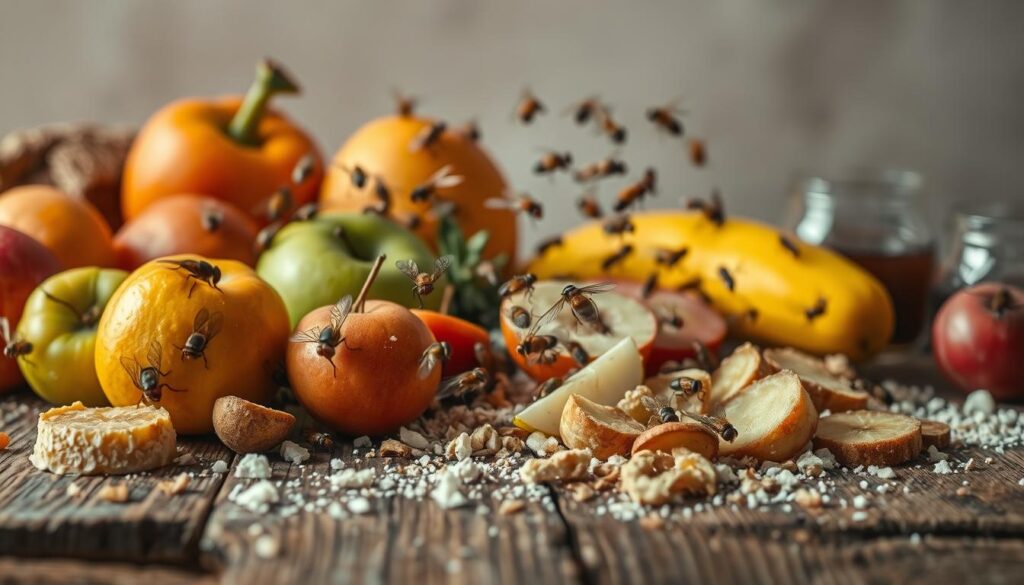
It’s important to know why flies come into your home. They look for food, shelter, and places to breed. By figuring out what draws them, you can take steps to keep them away.
Food Sources That Attract Flies
Flies are drawn to food that’s easy to find and get to. Common attractants include:
- Overripe or rotting fruit and vegetables
- Uncovered trash and garbage
- Pet food left outdoors
- Dirty dishes and food residue
Keeping your home clean and food stored properly can help keep flies away.
Breeding Grounds in Your Home
Flies need certain conditions to breed, and your home might provide them. Common breeding grounds include:
- Drainage systems with organic buildup
- Moist areas around sinks and toilets
- Decaying matter in garbage disposals
Cleaning and maintaining these areas can stop fly breeding.
Seasonal Factors Affecting Fly Populations
Fly numbers can grow in certain seasons. Warmer weather and more humidity help them reproduce faster. Knowing these patterns helps you prepare and prevent them.
Entry Points You Might Be Missing
Flies can sneak into your home through many ways, often without you noticing. Common entry points include:
- Open windows and doors
- Gaps around vents and chimneys
- Cracks in walls and foundations
Sealing these spots is key to stopping flies from coming back.
Health Risks Associated with Fly Infestations
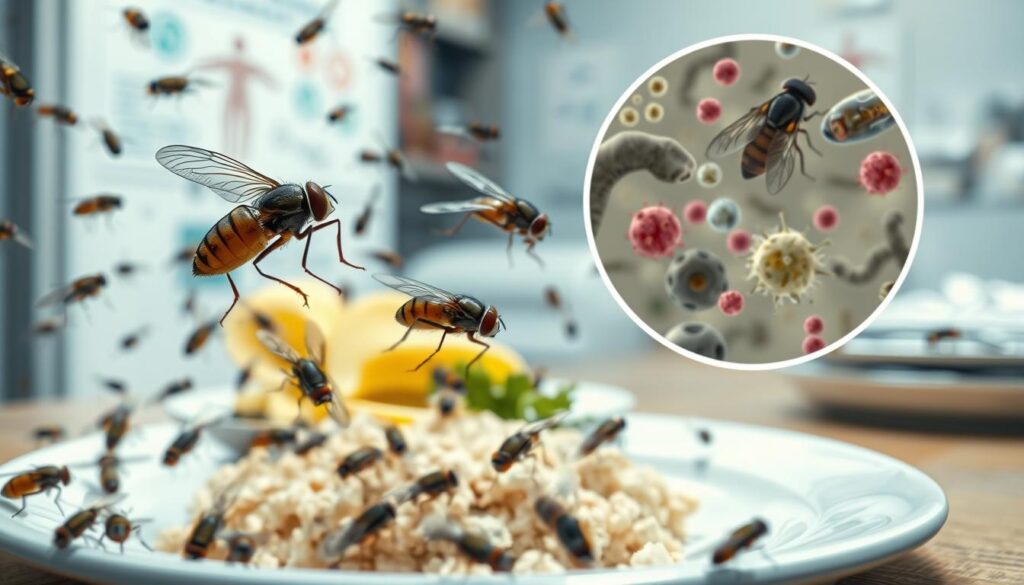
Flies are more than just annoying insects. They can spread diseases and contaminate your food and surfaces. When they land on your food or countertops, they leave behind harmful pathogens.
Diseases Transmitted by Flies
Flies carry diseases like typhoid fever, cholera, and dysentery. They pick up these pathogens from garbage, feces, or other contaminated sources. Then, they transfer them to your food or surfaces.
Contamination of Food and Surfaces
Flies are known for contaminating food and kitchen areas. They feed and land on various surfaces. This can lead to regurgitation on food, leaving behind harmful bacteria and pathogens.
Allergic Reactions and Asthma Triggers
Fly infestations can worsen allergies and asthma. The body parts and waste of flies can become airborne. This can trigger allergic reactions or asthma attacks in sensitive individuals.
When to Consider Professional Help
If you can’t get rid of flies despite your efforts, it’s time to call professionals. Pest control services can find the source of the infestation. They provide targeted treatments to get rid of the flies.
| Disease/Condition | How Flies Contribute |
|---|---|
| Typhoid Fever | Flies can carry Salmonella Typhi bacteria from feces to food and surfaces. |
| Cholera | Flies can transfer Vibrio cholerae from contaminated feces to food and water. |
| Allergic Reactions | Body parts and waste of flies can become airborne, triggering allergies. |
How to Get Rid of Flies: Immediate Action Steps
Don’t let flies take over your home. Take immediate action with these effective strategies. Getting rid of flies needs a multi-step approach. This includes identifying the source, cleaning effectively, and removing attractants and access points.
Identifying the Source of Infestation
The first step is to find where flies are coming from. They are drawn to food, moisture, and warmth. So, check areas where these conditions exist.
Kitchen Assessment Checklist
- Check for dirty drains and disposal units
- Inspect trash cans and recycling bins
- Look for spills and stains on countertops and floors
- Examine fruit and vegetable storage areas
Bathroom Inspection Points
- Inspect sink drains and pipes for blockages
- Check for leaky faucets and toilets
- Look for soap scum and mildew buildup
Cleaning Strategies for Quick Results
After finding the source, it’s time to clean and disinfect. Deep cleaning is key to remove dirt, grime, and bacteria that flies like.
Deep Cleaning Protocols
- Clean and disinfect all surfaces, including countertops, sinks, and floors
- Use a drain cleaner to clear blockages and deodorize drains
- Take out the trash and recycling regularly
- Wipe down surfaces with soap and water
Removing Attractants and Access Points
Flies are drawn to food, moisture, and warmth. Removing these attractants is key. Sealing entry points around your home also helps prevent re-infestation.
Sealing Techniques for Windows and Doors
- Use weatherstripping to seal gaps around doors and windows
- Install door sweeps to prevent flies from entering under doors
- Screen windows and vents to keep flies out
By following these steps, you can get rid of flies and stop them from coming back. Stay vigilant and keep your home clean and fly-free.
Natural Remedies and DIY Fly Control Solutions
Fly infestations can be frustrating, but there are many natural remedies and DIY solutions. These methods are effective and safe for your family and pets.
Essential Oils That Repel Flies
Certain essential oils repel flies, like peppermint, lemongrass, and lavender. You can use them alone or mix them for a strong repellent.
Creating Effective Essential Oil Sprays
To make an essential oil spray, mix a few drops of your chosen oil with water in a spray bottle. Add a bit of dish soap to help the oil mix. Spray this solution where flies are present.
Homemade Fly Traps That Actually Work
Homemade fly traps are a cost-effective and easy way to catch flies. Two simple methods include using apple cider vinegar and a wine bottle.
Apple Cider Vinegar Trap Instructions
Fill a jar with apple cider vinegar and cover it with plastic wrap. Poke small holes in the plastic wrap. Flies are drawn to the vinegar and get trapped inside the jar.
Wine Bottle Trap Method
Empty a wine bottle and leave a small amount of wine at the bottom. Place the bottle near where flies are present. Flies will be attracted to the wine and get trapped in the bottle.
Vinegar and Dish Soap Solutions
A mix of vinegar and dish soap can kill flies. The soap breaks the vinegar’s surface tension, causing flies to sink when they land.
Plants That Naturally Deter Flies
Certain plants, like citronella, basil, and mint, repel flies. Planting these in your garden or keeping them in pots indoors can help reduce fly infestations.
Commercial Products for Effective Fly Elimination
When DIY methods don’t work, commercial products can change the game. They offer many solutions for homeowners with fly problems.
Fly Traps and Sticky Papers: Pros and Cons
Fly traps and sticky papers are common for controlling flies. They’re easy to use and can help reduce fly numbers. But, they might not work for big fly problems and their success depends on where they’re placed.
Pros: Easy to use, no chemicals, and can be placed anywhere.
Electronic Fly Zappers and UV Light Traps
Electronic fly zappers and UV light traps are another choice. They attract flies to UV light and then kill them. These traps work well for some fly types but might not solve the whole problem.
Key benefits: Good for some fly types, can be used indoors.
Chemical Sprays and Foggers: When to Use Them
Chemical sprays and foggers can help with big fly problems. But, use them carefully and follow the instructions.
Safety Precautions for Chemical Products
When using chemical sprays and foggers, safety is key:
- Wear protective clothing and eyewear.
- Follow the manufacturer’s instructions.
- Avoid spraying near food or water sources.
- Keep pets and children away from treated areas.
Professional-Grade Solutions for Severe Infestations
For really bad fly problems, you might need professional-grade solutions. These are stronger than what you can buy and should be used by experts.
Knowing about commercial products helps you choose the best way to get rid of flies at home.
Long-Term Prevention Strategies
Keeping your home fly-free is possible with cleanliness, waste management, and sealing entry points. To keep your home fly-free, you need a multi-faceted approach. This approach should tackle the main reasons for fly infestations.
Sealing Entry Points Around Your Home
Flies can sneak into your home through tiny openings. It’s important to seal all possible entry points. Start by checking your home’s outside, focusing on windows, doors, vents, and chimneys.
Proper Food Storage Techniques
Flies are drawn to food, so storing it right is key. Use airtight containers for fruits, veggies, and grains. Keep your kitchen counters and sink clean and dry.
Waste Management Best Practices
Good waste management stops fly infestations. Clean and disinfect trash cans often. Make sure they’re tightly sealed. Use trash cans with fly-proof lids for extra protection.
Composting Without Attracting Flies
If you compost, do it in a way that doesn’t attract flies. Use a compost bin with a tight lid. Balance “green” and “brown” materials to avoid smells. Regularly turning your compost helps keep flies away.
Regular Cleaning Routines That Prevent Flies
Keeping your home clean is a top way to stop fly infestations. Sweep and mop floors often, where food is made or eaten. Clean under appliances and in hard-to-reach spots where crumbs and spills can hide.
By using these long-term prevention strategies, you can lower the chance of fly infestations at home. Remember, being consistent is important. Make these habits a regular part of your household routine.
Specific Solutions for Different Types of Flies
Dealing with fruit flies, drain flies, or cluster flies needs special strategies. Each type of fly needs a unique approach to get rid of them.
Targeting Fruit Flies in the Kitchen
Fruit flies love sweet, fermented, or decaying things. To get rid of them, find and remove their food sources.
Refrigeration Strategies for Produce
Keep fruits and veggies in the fridge or sealed containers. This stops fruit flies from getting to them. Also, clean and sanitize surfaces, like sinks and countertops, often.
Eliminating Drain Flies from Bathrooms
Drain flies like moist places, like clogged or dirty drains. To get rid of them, clean and unclog your drains.
Drain Cleaning Methods
Use a drain snake or plumber’s auger to clear blockages. Then, pour baking soda and vinegar down the drain to clean and freshen it.
Dealing with Seasonal Cluster Fly Invasions
Cluster flies come in the fall. To stop them, seal your home’s entry points. Check around windows, doors, and vents for cracks and crevices.
Managing Outdoor Fly Populations
Keep your yard clean and well-kept to manage outdoor fly populations.
Yard and Garden Maintenance Tips
| Task | Frequency | Benefits |
|---|---|---|
| Mow the lawn regularly | Weekly | Reduces hiding spots for flies |
| Remove weeds and debris | Bi-weekly | Eliminates breeding grounds |
| Keep trash cans clean and covered | Daily | Reduces attractants for flies |
Conclusion: Maintaining a Fly-Free Home Year-Round
You now have the tools and knowledge to keep your home free from flies. By understanding the types of flies that invade your space and the reasons behind their presence, you’re better equipped to tackle the problem.
To maintain a fly-free home, focus on fly prevention strategies. Regularly inspect your home for any places where flies might breed or enter. Use the cleaning strategies and natural remedies we discussed to keep flies away.
By combining these methods and staying vigilant, you’ll significantly reduce the likelihood of future fly infestations. Stay proactive, and you’ll enjoy a more comfortable and healthier living environment.
Maintaining a fly-free home is an ongoing process, but with persistence and the right techniques, you can achieve long-term results. Keep your home clean, store food properly, and eliminate standing water to ensure a fly-free future.


